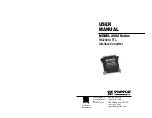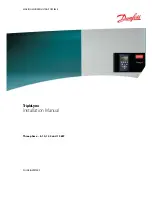
Page 8
SKU 02514
Warning: The generator weighs 2,205 lbs. Use care and the proper lifting or hoisting
equipment when moving it to the installation location. If hoisting with a crane, avoid
overhead power lines. Always connect hoist lines to the steel base of the generator.
Generator Location
• Locate and install the generator outdoors where cooling air is readily available. Do not
remove any part of the protective enclosure while operating.
• Install the generator so that the air inlets and outlets are not blocked by obstructions such
as bushes, trees, or snow drifts. Locating it in the path of heavy winds or snow drifts may
require the placement of a barrier for protection. The air inlet, in normal weather condi-
tions, should face the prevailing wind direction.
• Install the generator on a slab or other area where rain drainage or flood waters can not
reach it.
• Generator placement should allow four feet of access to all sides for maintenance.
• Place the generator as close as possible to the transfer switch and load to reduce the
length of cable runs.
• If the generator in located indoors, or in a generator house, the engine exhaust must be
ventilated to the outdoors using leakproof, heat resistant, metal flex tubing.
Transfer Switch Location
• Install the transfer switch indoors, and as close as possible to the (emergency) distribu-
tion panel, on a solid surface.
• Do not install the transfer switch where is can get wet or is exposed to moisture of any
kind. Avoid mounting in areas where there is corrosive vapors.
• Protect the transfer switch from dirt and dust.
Generator Support and Mounting
Mount the generator to a concrete slab able to support the weight of the generator. The
slab must extend beyond the steel base by at least one foot. Contact a cement contractor
for slab specifications if necessary. Attach the steel base to the concrete slab using large
and long, masonry type anchor bolts (not supplied).
Conduit and Wiring
All wiring must be of the proper AWG size and insulation, properly encased in NEC ap-
proved rigid conduit. Refer to the wiring illustrations on the next page.
Note : Specific generator voltage output, facility load, and transfer switch connections have
been left out, and should be at the discretion of the licensed electrical contractor for the
requirements of the facility load. It is important to balance all (phase) loads off the genera-
tor. If one phase draws more current than the others, damage can occur to the generator.
1.
Install the 1-1/2” rigid conduit from the generator connection box to the outside of the
generator housing. Mount a junction box which connects it to the external rigid conduit
routed to the transfer switch.





































